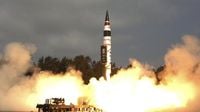In a dramatic escalation of hostilities between India and Pakistan, both nations have engaged in a series of intense military confrontations that have raised alarms globally. The situation, which has been brewing for weeks, reached a critical point on May 7, 2025, when over 100 fighter jets from both countries clashed in what has been described as one of the largest aerial battles since World War II.
According to reports from CNN, the aerial engagement involved approximately 125 warplanes, with India deploying its French-made Rafale jets against Pakistan's Chinese-made J-10C fighters. Pakistani officials claimed that their forces successfully shot down five Indian aircraft using advanced PL-15 missiles. While India has yet to confirm these losses, the implications of such military exchanges are profound.
This latest round of violence was triggered by a deadly attack on April 22, 2025, when armed gunmen killed 26 people, mostly Hindu tourists, in Pahalgam, Indian-administered Kashmir. India accused Pakistan of harboring the attackers, leading to a series of retaliatory strikes under the operation named "Operation Sindoor," which targeted nine locations across Pakistan and Pakistani-administered Kashmir.
In the wake of these strikes, Pakistan's military spokesperson, Lieutenant General Ahmed Sharif Chaudhry, issued a chilling warning: "When Pakistan strikes India, it will come at a time and place of its own choosing." This statement reflects the heightened tensions between the two nuclear-armed nations, each possessing roughly 170 nuclear warheads, as noted by the Stockholm International Peace Research Institute (SIPRI).
On May 8, the situation escalated further when Pakistan accused India of launching kamikaze drones into its airspace, claiming that these drones were shot down over major cities like Lahore and Karachi. India confirmed the drone assaults, stating they were a response to provocations from Pakistan, including missile launches targeting Indian cities and air defense systems.
Experts are increasingly concerned about the potential for a full-scale war, with Christopher Clary, an assistant professor of political science at the University at Albany, commenting that while both nations are still far from outright war, the situation is precarious. He noted, "We are much closer than we were 24 hours ago," indicating a rapid escalation in military posturing.
Amidst these tensions, analysts are also watching the international response closely. The U.S. Vice President, Vance, stated that the escalating conflict was "fundamentally none of our business," emphasizing a hands-off approach by the current administration. This contrasts sharply with previous U.S. interventions during past conflicts, such as those in 2019 and 1999.
As of May 10, 2025, the situation remains volatile. Pakistan has reportedly fired retaliatory missiles at Indian cities, including Amritsar and Jammu City, in response to India's earlier strikes. Pakistan's military claims that most of these missiles were intercepted, but the ongoing cross-border shelling has resulted in significant civilian casualties, with at least 31 reported dead in Pakistan and 13 in India.
Amid these developments, both nations are taking steps to bolster their military readiness. India has moved its naval fleet closer to Pakistan, positioning warships equipped with supersonic cruise missiles within striking distance of Karachi, Pakistan's largest port. This maneuver has raised concerns about the potential for catastrophic consequences should conflict escalate further.
In a chilling reminder of the stakes involved, military analysts have warned that any nuclear exchange between India and Pakistan could result in the deaths of up to 125 million people, according to research published in the Bulletin of the Atomic Scientists. The report details the immediate and long-term devastation that a nuclear conflict would unleash, not just in the region but globally.
The current conflict is not merely a bilateral issue but one that reflects broader geopolitical dynamics, particularly the influence of China, which has been a significant arms supplier to Pakistan. Over the past five years, China has provided 81 percent of Pakistan's imported weapons, according to SIPRI data. As the conflict unfolds, the international community is being urged to intervene to prevent further escalation.
In conclusion, the ongoing military confrontations between India and Pakistan have escalated to alarming levels, with both nations engaging in aggressive military strategies and rhetoric. The potential for a catastrophic conflict looms large, underscoring the urgent need for diplomatic intervention to de-escalate tensions and address the underlying issues that have fueled this decades-long rivalry.





